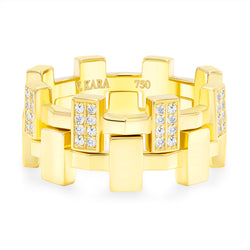In the world of jewelry, beauty is not just skin deep; it’s also about value—both sentimental and monetary. Whether you're considering parting ways with a cherished heirloom or eyeing an investment piece, understanding the factors that influence the resale value of jewelry is crucial. Let’s delve into the intricate facets that shape the worth of these exquisite adornments.
1. Material Matters: At the core of jewelry's value lies its material composition. Precious metals like gold, silver, and platinum hold intrinsic value, influenced by factors such as purity and weight. Similarly, gemstones—especially diamonds—add significant worth, with factors like carat weight, cut, clarity, and color playing pivotal roles.
2. Brand Prestige: The allure of a prestigious brand can elevate the value of jewelry. Pieces crafted by renowned designers or iconic jewelry houses often command premium prices due to their craftsmanship, heritage, and brand cachet. A Tiffany & Co. engagement ring or a Cartier bracelet, for instance, carries not just the weight of its materials but also the weight of its esteemed brand name.
3. Timeless vs. Trendy: Jewelry styles can be as fleeting as fashion trends or as enduring as love itself. Timeless designs with classic appeal tend to retain their value over time, transcending shifting trends. Conversely, pieces that align with passing fads may experience fluctuations in demand and value as tastes evolve.
4. Condition and Care: Just as a diamond requires polishing to reveal its brilliance, jewelry demands proper care to maintain its allure and value. Pieces in pristine condition, free from scratches, dents, or tarnish, fetch higher resale prices than those showing signs of wear and neglect. Regular maintenance, such as cleaning and professional inspections, can preserve both the aesthetic and economic value of jewelry.
5. Provenance and Story: Every piece of jewelry has a story to tell, and its provenance—whether it's a family heirloom passed down through generations or an exquisite creation with a captivating history—can imbue it with added value. Jewelry associated with notable figures, historical events, or renowned artisans carries a narrative that captivates collectors and connoisseurs alike.
6. Market Dynamics: The laws of supply and demand exert a significant influence on the resale value of jewelry. Market trends, consumer preferences, and economic conditions all shape the demand for specific styles, materials, and brands, thereby impacting their resale prices. Keeping abreast of market dynamics can help sellers maximize returns and buyers make informed investment decisions.
7. Documentation and Certification: Transparency is paramount in the world of jewelry resale. Documentation such as appraisals, certificates of authenticity, and receipts not only validate the authenticity and quality of jewelry but also instill confidence in buyers, thereby enhancing its resale value. Certifications from reputable gemological laboratories, such as GIA or AGS, provide assurance regarding the quality of gemstones, further bolstering their worth.
8. Quality of Craftsmanship: Exceptional craftsmanship elevates jewelry from mere accessories to wearable works of art. The skill and precision with which a piece is crafted can significantly enhance its appeal and value. Impeccable attention to detail, flawless execution of intricate designs, and superior finishing all contribute to the perceived value of jewelry. The mechanical parts, including the claps, hooks, and links, should all function properly.
9. Complexity and Labor Intensity: The complexity of a jewelry piece, as well as the labor intensity involved in its creation, directly influence its resale value. Intricately designed pieces that require meticulous handiwork and intricate setting techniques often command higher prices due to the skill and effort invest in their creation. Conversely, mass-produced or machine-made jewelry may have lower resale values, as they lack the uniqueness and artistry associated with handcrafted pieces.
10. Customization and Personalization: While customization adds a personal touch to jewelry, its impact on resale value can vary. Custom-made pieces tailored to specific tastes may hold sentimental value for the owner but may not necessarily command higher resale prices unless the customization is perceived as adding significant value by potential buyers.
In conclusion, the resale value of jewelry is a multifaceted realm where material composition, brand prestige, design aesthetics, condition, provenance, market dynamics, documentation, and customization intertwine to shape its worth. By navigating these factors with care and insight, both sellers and buyers can unlock the full potential of these exquisite treasures, ensuring that their beauty endures through generations, both in memory and in value.



Leave a comment